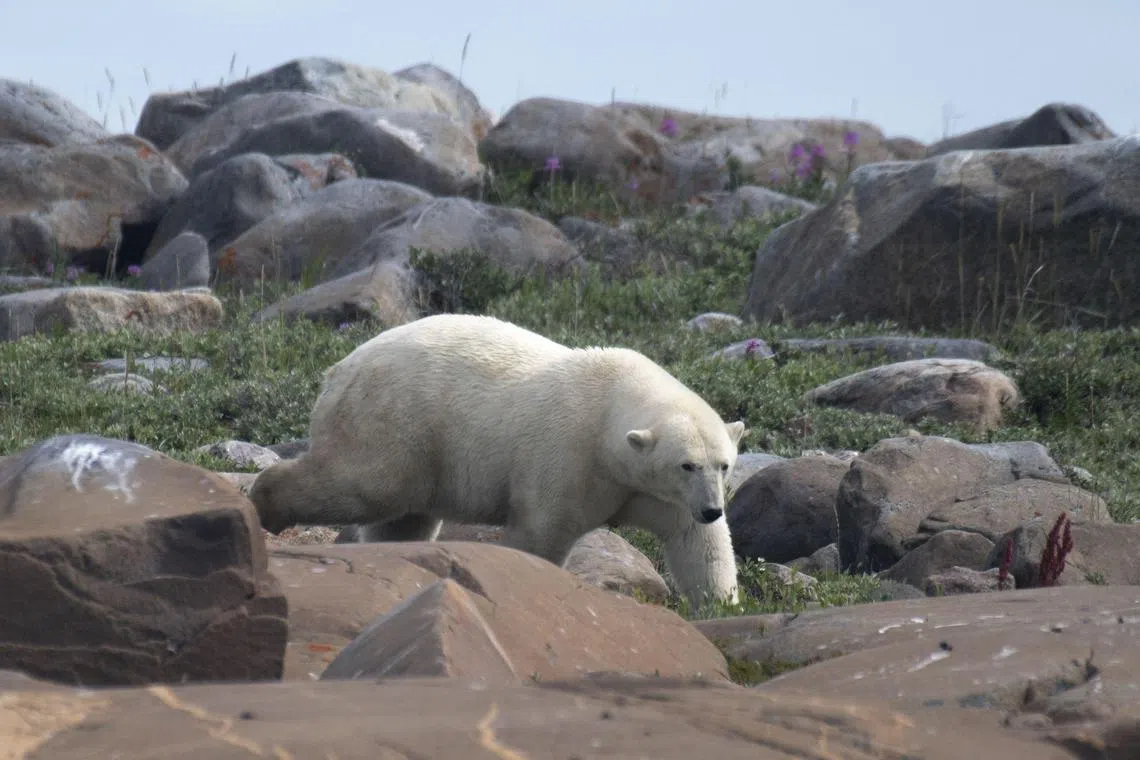Study quantifies link between greenhouse gases, polar bear survival
Sign up now: Get ST's newsletters delivered to your inbox

Quantifying the impact of a single oil well or coal power plant on the outlook for polar bears had eluded scientists, until now.
PHOTO: AFP
Follow topic:
WASHINGTON – Polar bears have long symbolised the dangers posed by climate change as rising temperatures melt away the Arctic sea ice which they depend upon for survival.
But quantifying the impact of a single oil well or coal power plant on the tundra predators had eluded scientists, until now.
A new report published in the journal Science on Thursday shows it is possible to calculate how much new greenhouse gas emissions will increase the number of ice-free days in the bears’ habitats, and how that in turn will affect the percentage of cubs that reach adulthood.
By achieving this level of granularity, the two authors hope to close a loophole in US law.
Although the apex carnivores have had endangered-species protections since 2008, a longstanding legal opinion prevents climate considerations from affecting decisions on whether to grant permits to new fossil fuel projects.
“We have presented the information necessary to rescind the Bernhardt Memo,” first co-author Steven Amstrup, a zoologist with Polar Bears International and the University of Wyoming, told AFP, referring to the legal caveat which was named after an attorney in former US president George W. Bush’s administration.
The memo stated it was beyond the scope of existing science to distinguish the impacts of a specific source of carbon emissions from the impacts of all greenhouse gases since the beginning of the industrial age.
Cub survival imperiled
Polar bears rely heavily on the sea ice environment for hunting seals, travelling, mating and more.
When sea ice melts in summer, the bears retreat onto land or unproductive ice far from the shore, where they endure long stretches of fasting. These periods are growing longer as global temperatures rise.
A landmark paper published in Nature in 2020 was the first to calculate links between climate-caused changes in the sea ice and polar bear demographics.
Building on this work, Dr Amstrup and second co-author Cecilia Bitz, a climatologist, established the mathematical relationships between greenhouse emissions and fasting days as well as cub survival in 15 out of 19 of the polar bears’ sub-populations between 1979 and 2020.
For example, the world now emits 50 billion tonnes of carbon dioxide or equivalent gases into the atmosphere annually, and that is reducing the rate of cub survival by more than 3 percentage points per year in the South Beaufort Sea sub-population.

It is now possible to calculate how much new greenhouse gas emissions will increase the number of ice-free days in the bears’ habitats, and how that in turn will affect the percentage of cubs that reach adulthood.
PHOTO: AFP
In healthy populations, cub survival during the first year of life is around 65 per cent.
“You don’t have to knock that down very far before you don’t have enough cubs entering the next generation,” said Dr Amstrup.
In addition, the paper provides US policymakers with the tools they need to quantify the impact of new fossil fuel projects slated to occur on public land in the coming decades.
Implications for other species
Professor Joel Berger, university chair of wildlife conservation at Colorado State University, praised the paper.
“Amstrup and Bitz render an incontrovertible quantitative link among (greenhouse gas) emissions, sea ice decline, fasting duration – a physiological response to lost hunting opportunities for seals – and subsequent polar bear demographics – declining recruitment of young,” said Prof Berger, who was not involved in the research.
Beyond providing a potential policy solution to the legal loophole, the new research could have implications that reach far beyond polar bears, Professor Bitz, a climatologist at the University of Washington, told AFP.
Methods laid out in the paper can be adapted for other species and habitats, such as coral reefs, or key deer of the Florida Keys.
“I really hope this stimulates a lot of research,” Prof Bitz said, adding that she was already reaching out to new collaborators. AFP

